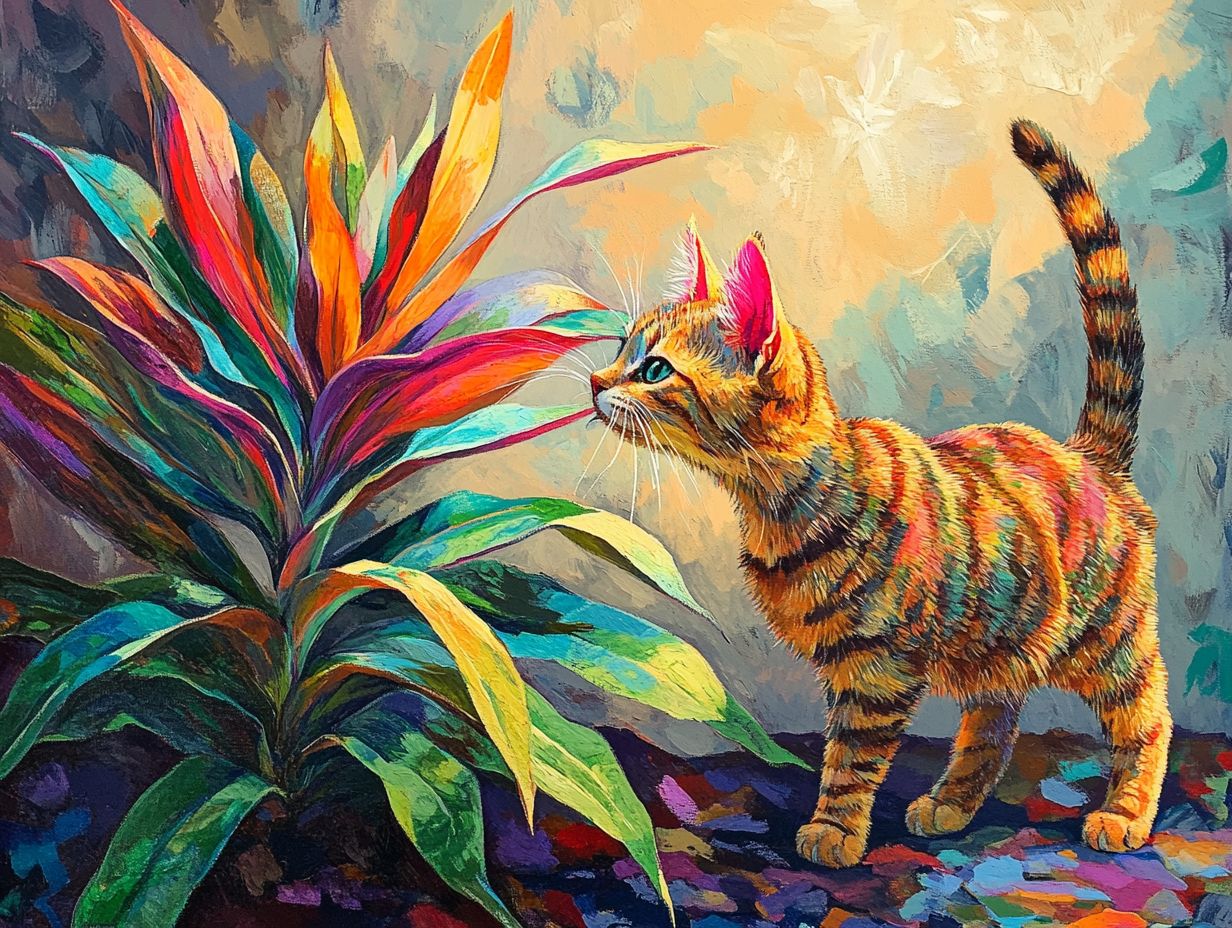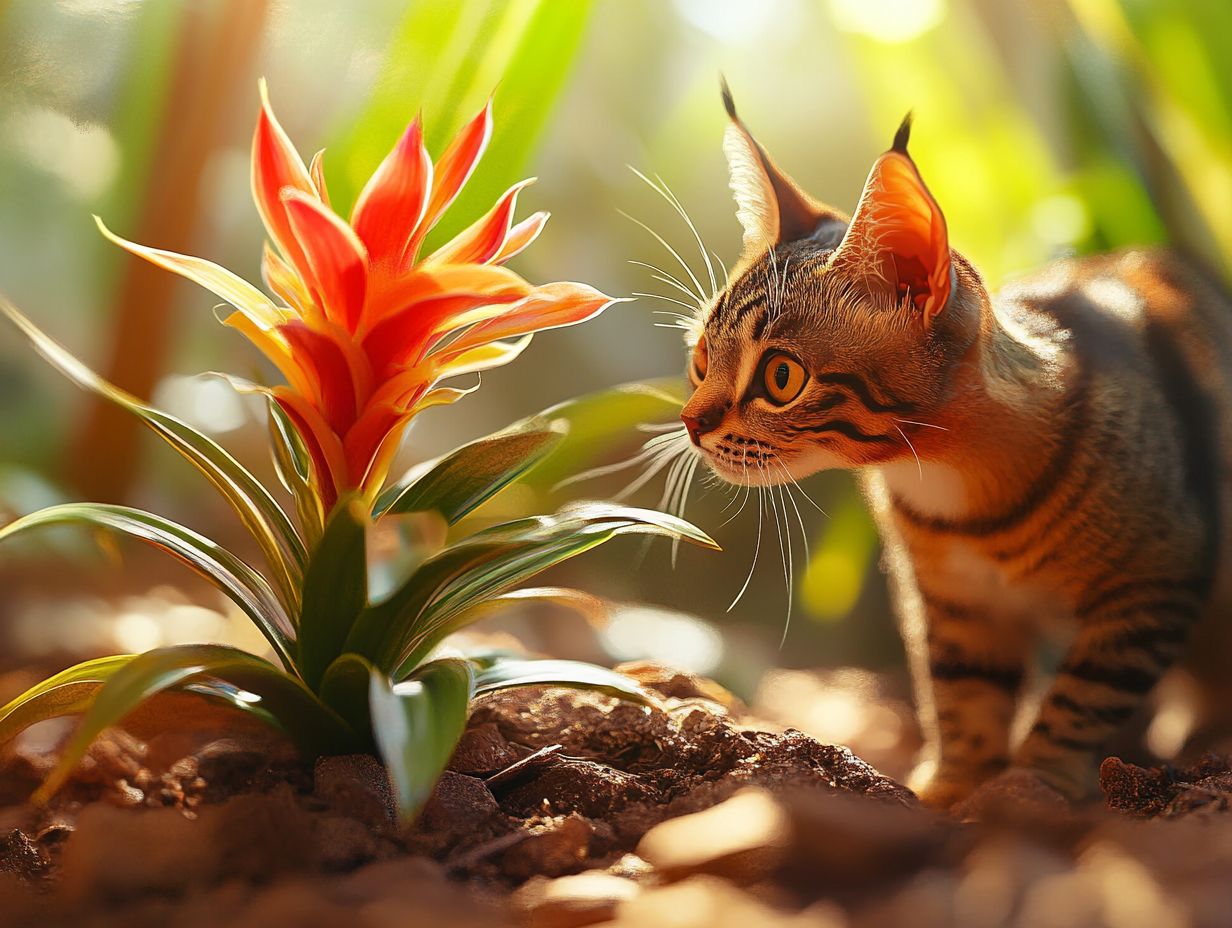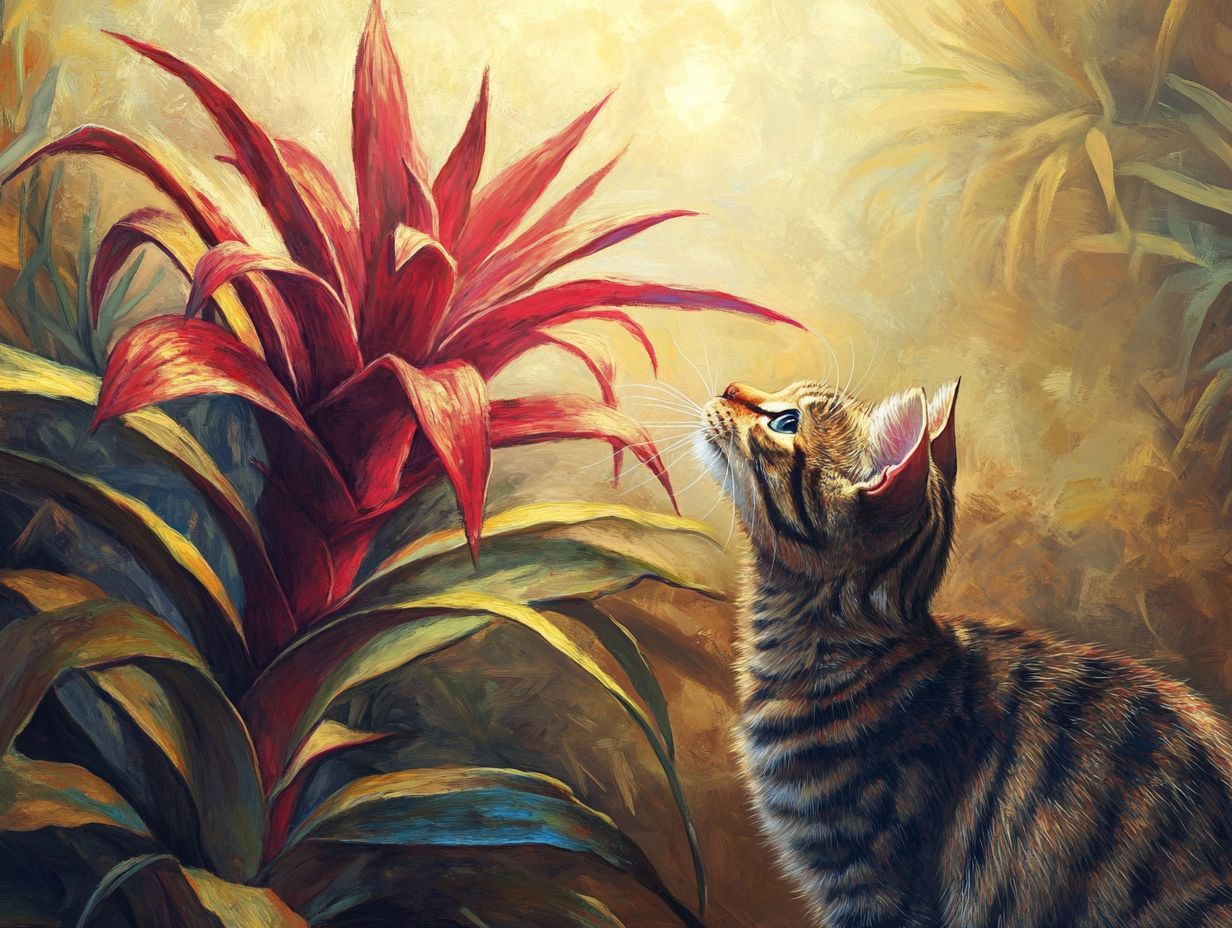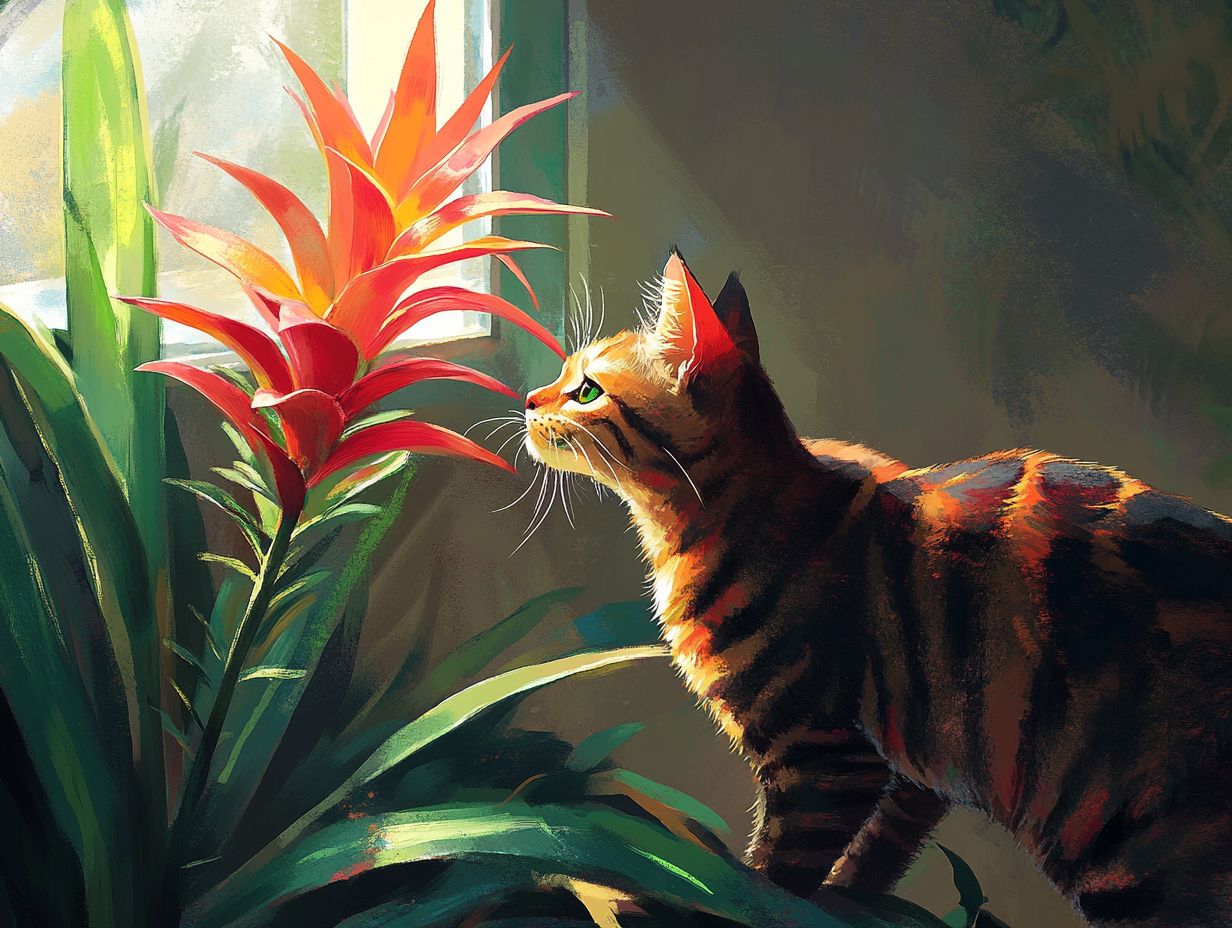Bromeliads, including the popular Blushing Bromeliad (Neoregelia carolinae), are vibrant, eye-catching plants that can bring a pop of color to any home. If you’re a cat parent, you might be wondering whether these beautiful plants are toxic to cats and safe for your furry friend.
This article explores the potential toxicity of bromeliads for cats, identifying which parts of the plant pose risks and the symptoms of bromeliad toxicity to watch for. Additionally, we will discuss what to do if your cat ingests bromeliads, including immediate veterinary intervention, along with safe plant alternatives to bromeliads for a cat-friendly environment. There are also tips on keeping your curious kitty safe around houseplants through safety measures and cat-proofing.
Read on to ensure your home is both beautiful and safe for your feline companion by preventing toxicity and monitoring your cat closely!
Key Takeaways:

- Bromeliads can be harmful to cats if ingested, but with proper home care and cat-proofing strategies, you can ensure your cat’s safety.
- If your cat has ingested a bromeliad, immediate veterinary intervention is crucial to ensure their well-being.
- There are many cat-friendly houseplant options, such as non-toxic plants, that can provide benefits for both your cat and your home. Be sure to research and take precautions when introducing new plants into your home to keep your cat safe.
What Are Bromeliads?
Bromeliads are a diverse group of tropical plants renowned for their distinctive rosette shape and vibrant colors. Species such as Neoregelia Shenba, Aechmea, and Billbergia have captivated both plant enthusiasts and interior decorators.
These ornamental plants thrive in a variety of environments, from natural tropical settings to indoor living spaces, adding beauty and character to any location. Understanding the characteristics and care of bromeliads is essential for both plant lovers and pet owners, particularly regarding their impact on household pets like cats. It’s important to note that some species, including Puya, might require extra caution.
Are Bromeliads Safe for Cats?
Yes, bromeliads are generally safe for cats, although some species can be toxic and may lead to health issues that require veterinary attention. Many cats show little to no interest in these plants, which minimizes the risk of bromeliad ingestion.
However, if your cat does consume any part of a bromeliad, it is important to know how to prevent toxicity and what steps to take in case of ingestion.
What Parts of the Bromeliad are Toxic to Cats?
Certain parts of bromeliads can be toxic to cats, particularly in large doses, so pet owners should be aware of the signs of bromeliad toxicity. The leaves, flowers, and even the sap of some bromeliad varieties may contain harmful substances, such as saponins, that can cause gastrointestinal and other complications in cats.
Symptoms of Bromeliad Toxicity in Cats
- Mild Symptoms: Moderate drooling, decreased appetite.
- Moderate Symptoms: Vomiting, diarrhea, lethargy.
- Severe Symptoms: Respiratory issues, extreme lethargy, severe vomiting.
Understanding which parts are toxic is crucial for preventing unintentional exposure. Toxicity can often go undetected initially, as symptoms may start off mild and then escalate. Cats may accidentally ingest toxic portions of bromeliads by nibbling on the leaves or swatting at the flowers.
It is essential for cat owners to recognize subtle signs of bromeliad toxicity, as these symptoms can also indicate other medical problems. Observing a cat’s behavior after potential exposure and seeking veterinary assistance if symptoms persist is important to ensure the cat’s health is not compromised.
First Aid for Bromeliad Ingestion
- Remove any remaining plant material from your cat’s mouth.
- Contact your veterinarian immediately or the ASPCA Animal Poison Control.
- Monitor your cat for any symptoms and be prepared to provide information about the plant ingested.
Preventing Bromeliad Toxicity
To keep your bromeliads out of reach from cats, consider the following safety measures:
- Place bromeliads on high shelves or locations that are inaccessible to your cat.
- Use hanging baskets for your bromeliads.
- Research and opt for safe plant alternatives such as spider plants or cat grass.
Common Misconceptions about Bromeliads
Many people believe that all bromeliads are toxic to cats, but this is not entirely accurate. While some species are indeed harmful, many others are considered non-toxic. It’s essential to research the specific species before introducing them into your home.
Considerations for Specific Cat Types
Kittens, senior cats, or cats with existing health conditions may be at higher risk. Extra caution is advised for these cats regarding any potentially toxic plants.
Conclusion
Bromeliads can be a beautiful addition to your home, but it’s important to be informed about their potential risks to your cats. By understanding which species are safe and implementing preventative measures, you can create a safe and attractive environment for both your plants and your feline friends.
Last reviewed: [Insert Date]. Content will be updated regularly based on new research.
Bromeliads and Their Effects on Cats: Safety Guide
Pet owners should monitor their cats closely, particularly after possible exposure to bromeliads. Even minor changes should not be overlooked, as they may represent early warning signs that require veterinary attention. Regular health checks and an understanding of your cat’s typical behavior and routines will help you identify these indicators promptly.
Toxicity Information
Bromeliads are generally considered mildly toxic to cats. The primary risks are associated with the leaves and flowers, which can cause gastrointestinal upset if ingested.
Symptoms of Bromeliad Toxicity
- Mild: Drooling, mild vomiting
- Moderate: Vomiting, diarrhea, decreased appetite
- Severe: Lethargy, severe vomiting, difficulty breathing
What to Do if Your Cat Has Ingested Bromeliads?

If you suspect that your cat has ingested bromeliads, it is crucial to contact a veterinarian immediately, as prompt intervention significantly increases the chances of recovery. Inducing vomiting should only be considered under veterinary guidance.
Begin by calling your vet to discuss the situation; they may recommend inducing vomiting or administering activated charcoal to limit further absorption of the toxins. In severe cases, gastric lavage may be necessary.
First Aid and Treatment
Steps for suspected bromeliad poisoning:
- Contact your veterinarian or local poison control.
- Provide them with details about your cat’s symptoms and the plant ingested.
- Follow their instructions closely.
How to Induce Vomiting in Cats?
Inducing vomiting in cats after bromeliad ingestion can be beneficial, but it should only be done after consulting with a veterinarian. If your veterinarian advises it, you may induce vomiting using hydrogen peroxide; however, it is crucial to use the correct dose and concentration to avoid potential side effects.
Immediate veterinary care should be sought if severe symptoms develop following bromeliad ingestion. Inducing vomiting may not always be effective and could potentially exacerbate the situation, making it essential to consult with a veterinarian beforehand.
A veterinarian can provide guidance on whether inducing vomiting is appropriate and suggest alternative treatments if necessary. If you believe your pet’s symptoms warrant induced vomiting, seeking veterinary advice is the best way to ensure they receive proper care.
The well-being of your pet is the highest priority, and veterinarians are trained to determine the best steps to restore your animal’s health quickly and provide you with the most effective advice.
What Are the Treatment Options for Bromeliad Toxicity in Cats?
Treatment for bromeliad toxicity in cats primarily involves supportive care, with specific options depending on the severity of the situation. These treatments may include:
- Administering activated charcoal to absorb toxins
- Performing gastric lavage to remove harmful substances
- Intravenous fluid therapy, which helps flush out toxins and rehydrate the cat, particularly if it is in severe distress or showing signs of dehydration.
- Antiemetic medications to alleviate nausea and vomiting, preventing further deterioration of the cat’s condition.
While these treatments are generally effective, they can have side effects, such as fluid overload and allergic reactions to medications. Therefore, professional veterinary monitoring is vital to ensure the safety and recovery of the treated cat, especially with potential long-term concerns.
What Are the Non-Toxic Alternatives to Bromeliads for Cat-Friendly Houseplants?
Spider plants, bamboo, and cat grass are non-toxic alternatives to bromeliads, making them safe houseplants for cats. There are many cat-safe plants you can incorporate into your home decor while still enjoying the aesthetic benefits of having houseplants.
Examples of safe options, along with the convenience of artificial plants, include:
- African violets
- true palms
- Swedish ivy
What Are the Benefits of Having Houseplants for Cats?
Houseplants are beneficial for cats as they provide environmental enrichment and mental stimulation. Cats can enjoy the tactile sensation of leaves and the diverse scents of various plants, which encourage scratching and exploratory behaviors.
Incorporating cat-safe houseplants can create a more enriching environment that positively affects the well-being of both cats and humans at home. These plants add sensory engagement and visual appeal to indoor spaces, blending natural beauty with the playful antics of curious pets.
Some plants serve as interactive elements that help reduce boredom and stress. As cats interact with these plants, they find opportunities to hide, pounce, and sniff, nurturing their natural instincts.
Prevention and Safety Measures
To keep bromeliads and other potentially toxic plants out of reach of your cats, consider:
- Placing plants on high shelves or hanging planters.
- Using barriers or deterrent sprays to discourage cats from approaching certain areas.
- Choosing safe plant alternatives for your home.
Common Misconceptions
Many pet owners believe that all houseplants are safe for cats. This is not true; awareness of plant toxicity is essential for responsible pet ownership.
Special Considerations
Caution should be exercised with kittens, senior cats, or those with pre-existing health conditions, as they may be more vulnerable to the effects of toxins.
Call to Action
For personalized advice, always consult with your veterinarian. If you suspect poisoning, contact emergency veterinary poison control services immediately.
Disclaimer: This article is for informational purposes only and is not a substitute for professional veterinary advice. Always consult your veterinarian for the most accurate and appropriate care for your pet.
Last reviewed: October 2023
For more information on other common houseplants that are safe or toxic for cats, check out our related articles.
This combination of beauty and engagement makes the home environment more vibrant and enjoyable for everyone, including our feline companions.
What Are Some Cat-Friendly Houseplants?

Here are some of the most common cat-friendly houseplants:
- Spider plants
- Bamboo
- Cat grass
- African violets
- True palms
- Succulents
How to Keep Your Cat Safe Around Houseplants?
Ensuring your cat’s safety around houseplants involves implementing effective safety measures and cat-proofing strategies. This applies to all types of plants, including bromeliads, as it is essential to limit their location and accessibility to prevent accidental ingestion or toxicity.
By using barriers and selecting appropriate spots for your plants, you can significantly reduce risks and hazards.
What Precautions Should You Take When Bringing New Houseplants into Your Home, and Tips on Plant Placement?
When introducing new houseplants to your home, it’s essential to take precautions to keep your cats safe. Start by confirming that the plant species are non-toxic through thorough research or reliable sources like the ASPCA. Plan the placement of the plants to minimize the likelihood of feline access, and regularly monitor your pets’ interactions with the new additions to detect any signs of interest or potential issues, ensuring that they are toxic to cats.
Incorporating cat-safe plants, such as Neoregelia Shenba or Blushing Bromeliad (Neoregelia carolinae), into your indoor garden will allow you to cultivate a flourishing space without endangering your pets. A simple yet effective step is to place new plants out of reach, either on high shelves or in hanging planters, to reduce the temptation for curious cats.
Consistent observation of your cat’s behavior around the new plants will help you quickly identify any unwanted or unusual tendencies. Using non-toxic plants like spider plants, bamboo, cat grass, African violets, true palms, succulents, or Swedish ivy can further ensure safety. By maintaining regular vigilance, you can ensure the well-being of both your new plants and the playful spirit of your pets.
What Are Some Tips for Keeping Your Cat Away from Houseplants?
Several effective strategies can help keep cats away from houseplants. For starters, placing plants on higher shelves or using specific deterrents can reduce a cat’s natural urge to explore. The location of the plants is crucial in minimizing unwanted interactions. Consider cat-proofing your space by implementing barriers or using artificial plants as alternatives to bromeliads or other potentially harmful plants.
Physical barriers, such as decorative chicken wire or plant cages, can serve as visual and tactile deterrents, making the plants less enticing to curious paws. Additionally, applying unpleasant scents, such as citrus or vinegar, to the leaves can discourage cats from getting too close, thus preventing toxicity.
Redirecting a cat’s attention to a designated play area filled with engaging toys can satisfy their natural curiosity, keeping their paws and teeth away from your plants. For those concerned about plant safety, you can read more about Are Bromeliads Safe for Cats? A Vet’s Advice on Plant Safety. This resource provides valuable information derived from veterinary research.
Frequently Asked Questions
Are Bromeliads safe for cats?

Yes, Bromeliads are generally non-toxic for cats. No parts of the plant are toxic. However, be aware of sneaky symptoms and long-term concerns that might require vigilance.
What makes Bromeliads safe for cats?
Bromeliads do not contain any toxic substances that can harm cats. They are also not known to cause any allergic reactions in cats. However, ingestion may lead to mild gastrointestinal upset.
What are potential symptoms of Bromeliad ingestion?
- Mild: Vomiting, diarrhea
- Moderate: Lethargy, decreased appetite
- Severe: Persistent vomiting, severe lethargy (seek veterinary care immediately)
Can cats eat Bromeliads?
No, cats should not eat Bromeliads. While they are not toxic, they are not a suitable food source for cats and may cause digestive issues.
First Aid and Treatment
If a cat ingests part of a Bromeliad, contact your veterinarian immediately. Treatments may vary but can include monitoring, induced vomiting, or supportive care depending on the severity of symptoms.
Special Considerations
Kittens and senior cats may be more vulnerable to the effects of ingestion. It’s crucial to monitor their interactions with Bromeliads and other plants closely.
Common Misconceptions
Many believe that all houseplants are harmful to pets. In reality, many plants, including Bromeliads, are safe and can coexist with our furry friends when appropriately managed.
Disclaimer: The information provided here is for educational purposes only and should not replace professional veterinary advice. Always consult your vet for personalized guidance on pet safety.
Emergency Contact: For assistance, contact ASPCA Animal Poison Control.
Last updated: [Insert Last Updated Date]
Can cats play with Bromeliads?
Yes, cats can play with Bromeliads. However, it is essential to supervise their play and ensure they do not ingest any parts of the plant. According to the ASPCA, Bromeliads are considered non-toxic to cats, but caution is advised.
What should I do if my cat experiences bromeliad ingestion?
If your cat ingests a Bromeliad, monitor them closely for any symptoms of bromeliad toxicity or discomfort. Symptoms may be categorized as follows:
- Mild: Vomiting, diarrhea, mild lethargy
- Moderate: Increased drooling, abdominal pain, decreased appetite
- Severe: Respiratory distress, seizures, collapse
If you notice any symptoms, contact your veterinarian immediately for immediate veterinary intervention. Vet care is crucial to address any potential issues. For first aid, remove any remaining plant material and observe your cat’s condition closely.
Are there any safety measures I should take with Bromeliads around my cat?
It is best to keep Bromeliads out of reach of cats to prevent them from chewing or playing with the plant. You can also consider using deterrents, such as bitter sprays, to discourage cats from interacting with the plant. Employing gastric lavage or activated charcoal as part of home care measures in case of ingestion can also be useful steps. For safer alternatives, consider plants like spider plants or cat grass, which are non-toxic to cats.
Common Misconceptions
Some people believe that all indoor plants are harmful to pets, but this is not true for Bromeliads, which are generally safe. However, it is still important to monitor your pets around any plants.
Balanced Perspective
While Bromeliads are considered non-toxic, minor issues such as mild gastrointestinal upset can occur if a cat chews on the leaves. Always evaluate the risk versus the aesthetic benefit of having these plants in your home.
Special Considerations
Kittens and senior cats may be more sensitive to any ingestion. Seasonally, keep in mind that Bromeliads may attract pests, which could pose further risks to your pets.
Visual Aids
To assist in identification, it is helpful to include clear, labeled images of Bromeliads. Consider creating infographics summarizing key points regarding pet safety and plant toxicity.
Expert Input
Veterinarians recommend consulting your vet for personalized advice on plant safety in your home. Always be cautious and avoid making definitive claims without sufficient evidence.
Readability and Accessibility
We aim to simplify language and define any necessary medical terms, ensuring that the content is accessible to all readers.
Call to Action
For emergencies, contact the ASPCA Animal Poison Control at (888) 426-4435, and always encourage responsible pet ownership.
Updates and Revisions
This content will be regularly reviewed and updated as new research emerges. Last reviewed on: [Insert Date].
Cross-referencing
For comprehensive coverage, please refer to related topics such as plant toxicity and cat safety.
Legal Considerations
This content is for informational purposes only and does not substitute for medical advice. Please consult your veterinarian for any concerns.